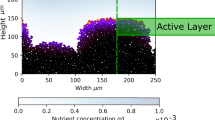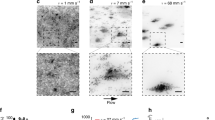Abstract
Biofilms are communities of bacteria adhered to surfaces. Recently, biofilms of rod-shaped bacteria were observed at single-cell resolution and shown to develop from a disordered, two-dimensional layer of founder cells into a three-dimensional structure with a vertically aligned core. Here, we elucidate the physical mechanism underpinning this transition using a combination of agent-based and continuum modelling. We find that verticalization proceeds through a series of localized mechanical instabilities on the cellular scale. For short cells, these instabilities are primarily triggered by cell division, whereas long cells are more likely to be peeled off the surface by nearby vertical cells, creating an ‘inverse domino effect’. The interplay between cell growth and cell verticalization gives rise to an exotic mechanical state in which the effective surface pressure becomes constant throughout the growing core of the biofilm surface layer. This dynamical isobaricity determines the expansion speed of a biofilm cluster and thereby governs how cells access the third dimension. In particular, theory predicts that a longer average cell length yields more rapidly expanding, flatter biofilms. We experimentally show that such changes in biofilm development occur by exploiting chemicals that modulate cell length.
This is a preview of subscription content, access via your institution
Access options
Access Nature and 54 other Nature Portfolio journals
Get Nature+, our best-value online-access subscription
$29.99 / 30 days
cancel any time
Subscribe to this journal
Receive 12 print issues and online access
$209.00 per year
only $17.42 per issue
Buy this article
- Purchase on Springer Link
- Instant access to full article PDF
Prices may be subject to local taxes which are calculated during checkout




Similar content being viewed by others
References
Ghannoum, M., Parsek, M., Whiteley, M. & Mukherjee, P. K. Microbial Biofilms 2nd edn (ASM, Washington DC, 2015).
Flemming, H. C. & Wingender, J. The biofilm matrix. Nat. Rev. Microbiol. 8, 623–633 (2010).
Gordon, V. D., Davis-Fields, M., Kovach, K. & Rodesney, A. Biofilms and mechanics: a review of experimental techniques and findings. J. Phys. D 50, 223002 (2017).
Hall-Stoodley, L., Costerton, J. W. & Stoodley, P. Bacterial biofilms: from the natural environment to infectious diseases. Nat. Rev. Microbiol. 2, 95–108 (2004).
Costerton, J. W., Stewart, P. S. & Greenberg, E. P. Bacterial biofilms: a common cause of persistent infections. Science 284, 1318–1322 (1999).
Stewart, E. J., Satorius, A. E., Younger, J. G. & Solomon, M. J. Role of environmental and antibiotic stress on Staphylococcus epidermidis biofilm microstructure. Langmuir 29, 7017–7024 (2013).
Drescher, K. et al. Architectural transitions in Vibrio cholerae biofilms at single-cell resolution. Proc. Natl Acad. Sci. USA 113, E2066–E2072 (2016).
Yan, J., Sharo, A. G., Stone, H. A., Wingreen, N. S. & Bassler, B. L. Vibrio cholerae biofilm growth program and architecture revealed by single-cell live imaging. Proc. Natl Acad. Sci. USA 113, E5337–E5343 (2016).
Teschler, J. K. et al. Living in the matrix: assembly and control of Vibrio cholerae biofilms. Nat. Rev. Microbiol. 13, 255–268 (2015).
Bartlett, T. M. et al. A periplasmic polymer curves Vibrio cholerae and promotes pathogenesis. Cell 168, 172–185 (2017).
Onsager, L. The effects of shape on the interaction of colloidal particles. Ann. NY Acad. Sci. 51, 627–659 (1949).
Berk, V. et al. Molecular architecture and assembly principles of Vibrio cholerae biofilms. Science 337, 236–239 (2012).
Doostmohammadi, A., Thampi, S. P. & Yeomans, J. M. Defect-mediated morphologies in growing cell colonies. Phys. Rev. Lett. 117, 048102 (2016).
Duvernoy, M.-C. et al. Asymmetric adhesion of rod-shaped bacteria controls microcolony morphogenesis. Nat. Commun. 9, 1120 (2018).
Enos-Berlage, J. L. & McCarter, L. L. Relation of capsular polysaccharide production and colonial cell organization to colony morphology in Vibrio parahaemolyticus. J. Bacteriol. 182, 5513–5520 (2000).
Boyer, D. et al. Buckling instability in ordered bacterial colonies. Phys. Biol. 8, 026008 (2011).
Smith, W. P. J. et al. Cell morphology drives spatial patterning in microbial communities. Proc. Natl Acad. Sci. USA 114, E280–E286 (2016).
You Z., Pearce, D. J. G., Sengupta, A. & Giomi, L. Geometry and mechanics of micro-domains in growing bacterial colonies. Preprint at https://arxiv.org/abs/1703.04504 (2017).
Mamou, G., Mohan, G. B. M., Rouvinski, A., Rosenberg, A. & Ben-Yehuda, S. Early developmental program shapes colony morphology in bacteria. Cell Rep. 14, 1850–1857 (2016).
Grant, M. A. A., Waclaw, B., Allen, R. J. & Cicuta, P. The role of mechanical forces in the planar-to-bulk transition in growing Escherichia coli microcolonies. J. R. Soc. Interface https://doi.org/10.1098/rsif.2014.0400 (2014).
Su, P.-T. et al. Bacterial colony from two-dimensional division to three-dimensional development. PLoS One 7, e48098 (2012).
Asally, M. et al. Localized cell death focuses mechanical forces during 3D patterning in a biofilm. Proc. Natl Acad. Sci. USA 109, 18891–18896 (2012).
Kumar, N., Soni, H., Ramaswamy, S. & Sood, A. K. Flocking at a distance in active granular matter. Nat. Commun. 5, 4688 (2014).
Narayan, V., Ramaswamy, S. & Menon, N. Long-lived giant number fluctuations in a swarming granular nematic. Science 317, 105–108 (2007).
Yadav, V., Chastaing, J.-Y. & Kudrolli, A. Effect of aspect ratio on the development of order in vibrated granular rods. Phys. Rev. E 88, 052203 (2013).
Farrell, F. D. C., Hallatschek, O., Marenduzzo, D. & Waclaw, B. Mechanically driven growth of quasi-two-dimensional microbial colonies. Phys. Rev. Lett. 111, 168101 (2013).
Ghosh, P., Mondal, J., Ben-Jacob, E. & Levine, H. Mechanically-driven phase separation in a growing bacterial colony. Proc. Natl Acad. Sci. USA 112, E2166–E2173 (2015).
Lardon, L. A. et al. iDynoMiCS: next-generation individual-based modelling of biofilms. Env. Microbiol. 13, 2416–2434 (2011).
Chen, Y., van der Mei, H. C., Busscher, H. J. & Norde, W. Viscous nature of the bond between adhering bacteria and substratum surfaces probed by atomic force microscopy. Langmuir 30, 3165–3169 (2014).
Barthel, E. Adhesive elastic contacts - JKR and more. J. Phys. D 41, 163001 (2008).
Candelier, R., Dauchot, O. & Biroli, G. Dynamical facilitation decreases when approaching the granular glass transition. Eur. Phys. Lett. 92, 24003 (2010).
White, C. L., Kitich, A. & Gober, J. W. Positioning cell wall synthetic complexes by the bacterial morphogenetic proteins MreB and MreD. Mol. Microbiol. 76, 616–633 (2010).
Yang, D. C., Blair, K. M. & Salama, N. R. Staying in shape: the impact of cell shape on bacterial survival in diverse environments. Microbiol. Mol. Biol. Rev. 80, 187–203 (2016).
Young, K. D. The selective value of bacterial shape. Microbiol. Mol. Biol. Rev. 70, 660–703 (2006).
Stocker, R. & Seymour, J. R. Ecology and physics of bacterial chemotaxis in the ocean. Microbiol. Mol. Biol. Rev. 76, 792–812 (2012).
Chang, F. & Huang, K. C. How and why cells grow as rods. BMC Biol. 12, 54 (2014).
Jubair, M., Morris, J. G.Jr. & Ali, A. Survival of Vibrio cholerae in nutrient-poor environments is associated with a novel “persister” phenotype. PLoS One 7, e45187 (2012).
Yan, J., Nadell, C. D., Stone, H. A., Wingreen, N. S. & Bassler, B. L. Extracellular-matrix-mediated osmotic pressure drives Vibrio cholerae biofilm expansion and cheater exclusion. Nat. Commun. 8, 327 (2017).
Vicsek, T. Fluctuations and Scaling in Biology (Oxford Univ. Press, Oxford, 2001).
Fisher, R. A. The wave of advance of advantageous genes. Ann. Eugen. 7, 353–369 (1937).
von Saarloos, W. Front propagation into unstable states. Phys. Rep. 386, 29–222 (2003).
Fort, J. & Pujol, T. Progress in front propagation research. Rep. Prog. Phys. 71, 086001 (2008).
Puliafito, A. et al. Collective and single cell behavior in epithelial contact inhibition. Proc. Natl Acad. Sci. USA 109, 739–744 (2012).
Delarue, M. et al. Self-driven jamming in growing microbial populations. Nat. Phys. 12, 762–766 (2016).
Bi, D., Lopez, J. H., Schwarz, J. M. & Manning, M. L. A density-independent rigidity transition in biological tissues. Nat. Phys. 11, 1074–1078 (2015).
Marchetti, M. C. et al. Hydrodynamics of soft active matter. Rev. Mod. Phys. 85, 1143 (2013).
Beyhan, S. & Yildiz, F. H. Smooth to rugose phase variation in Vibrio cholerae can be mediated by a single nucleotide change that targets c-di-GMP signaling pathway. Mol. Microbiol. 63, 995–1007 (2007).
Landau, L. D., Lifshitz, E. M., Kosevich, A. M. & Pitaevskii, L. P. Theory of Elasticity (Pergamon Press, Oxford, 1986).
Galassi, M. et al. GNU Scientific Library Reference Manual 3rd edn (Network Theory Ltd, Godalming, 2017).
Guyer, J. E., Wheeler, D. & Warren, J. A. FiPy: Partial differential equations with Python. Comp. Sci. Eng. 11, 6–15 (2009).
Acknowledgements
We thank B. Bratton, X. Chen, S. Jena, N. Pappireddi and J. Shaevitz for insightful discussions and encouragement, G. Laevsky for assistance with imaging and T. Bartlett and Z. Gitai for sharing the ΔcrvA strain and reagents. This work was supported by the NIH under grant no. R01 GM082938 (F.B., Y.M. and N.S.W.), the Howard Hughes Medical Institute (B.L.B.), NSF grant MCB-1713731 (B.L.B.), NSF grant MCB-1344191 (H.A.S., B.L.B. and N.S.W.), NIH grant 2R37GM065859 (F.B. and B.L.B.), the Max Planck Society-Alexander von Humboldt Foundation (B.L.B.) and the Eric and Wendy Schmidt Transformative Technology Fund from Princeton University (H.A.S., B.L.B. and N.S.W.). J.Y. holds a Career Award at the Scientific Interface from the Burroughs Wellcome Fund.
Author information
Authors and Affiliations
Contributions
F.B., J.Y., and N.S.W. conceived the research. F.B. performed all simulations and analysis. J.Y. carried out all experiments, and J.Y. and F.B. contributed to the experimental design. All authors contributed to the manuscript preparation.
Corresponding author
Ethics declarations
Competing interests
The authors declare no competing interests.
Additional information
Publisher’s note: Springer Nature remains neutral with regard to jurisdictional claims in published maps and institutional affiliations.
Supplementary information
Supplementary Information
Supplementary Information, Supplementary Figures 1–16, Supplementary Discussion, Supplementary References 1–20
Supplementary Video 1
Growth of a V. cholerae biofilm cluster, showing cross-sectional images of the bottom cell layer. The strain constitutively expresses mKO. The viewing window is 45 by 45 µm2 and the total duration is 8 hours with 10 min time steps.
Supplementary Video 2
Visualization of the surface layer of a modelled biofilm with initial cell cylinder length \({\ell }_{0}\) = 1 µm, showing positions and orientations of horizontal (blue) and vertical (red) surface-adhered cells as spherocylinders of radius R = 0.8 µm, with the surface shown at height z = 0 µm (brown). Cells with nz < 0.5 (>0.5) are considered horizontal (vertical), where \({{\bf{{n}}}}\) is the orientation vector. Scale bar, 3 µm. The total duration is 10 hours.
Supplementary Video 3
Visualization of the surface layer of a modelled biofilm with initial cell cylinder length \({\ell }_{0}\) = 2 µm, showing horizontal (blue) and vertical (red) cells as spherocylinders, the surface (brown), and cell-to-cell contact forces (yellow lines connecting the centres of cells, with thicknesses proportional to the force). Cells with nz < 0.5 (>0.5) are considered horizontal (vertical), where \({{\bf{{n}}}}\) is the orientation vector. The length of the scale bar is 3 µm, and its thickness corresponds to 300 pN.
Supplementary Video 4
Numerical simulation of the continuum model assuming no vertical cell transport, showing radial densities of horizontal cells (ρh, blue), vertical cells (ρv, red), and total density (\({\widetilde{\rho }}_{{\rm{tot}}}\)= ρh + ξρv, black), versus radial coordinate r for isobaric regime with \({\widetilde{\rho }}_{0}\) = 1 m−2, \({\widetilde{\rho }}_{{\rm{t}}}\) = 1.5 m−2, β = 2.5α, and ξ = 0.5. Dashed grey line shows \({\widetilde{\rho }}_{{\rm{t}}}.\)
Supplementary Video 5
Expansion of V. cholerae biofilm clusters grown with the drug A22 at a concentration of 0.4 µg mL–1 (left) and the drug Cefalexin at a concentration of 4 µg mL–1 (right). Cross-sectional images of the bottom cell layers are shown. The strain constitutively expresses mKO. Scale bar, 30 µm. The total duration is 10 hours with 30 min time steps.
Rights and permissions
About this article
Cite this article
Beroz, F., Yan, J., Meir, Y. et al. Verticalization of bacterial biofilms. Nature Phys 14, 954–960 (2018). https://doi.org/10.1038/s41567-018-0170-4
Received:
Accepted:
Published:
Issue Date:
DOI: https://doi.org/10.1038/s41567-018-0170-4
This article is cited by
-
Biofilms as self-shaping growing nematics
Nature Physics (2023)
-
Proliferating active matter
Nature Reviews Physics (2023)
-
Morphogenesis in space offers challenges and opportunities for soft matter and biophysics
Communications Physics (2023)
-
Collective mechano-response dynamically tunes cell-size distributions in growing bacterial colonies
Communications Physics (2023)
-
Active layer dynamics drives a transition to biofilm fingering
npj Biofilms and Microbiomes (2023)



